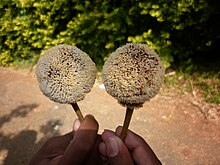| Parkia | |
|---|---|

| |
| Parkia platycephala | |
|
Scientific classification
| |
| Kingdom: | Plantae |
| Clade: | Tracheophytes |
| Clade: | Angiosperms |
| Clade: | Eudicots |
| Clade: | Rosids |
| Order: | Fabales |
| Family: | Fabaceae |
| Subfamily: | Caesalpinioideae |
| Clade: | Mimosoid clade |
| Genus: |
Parkia R.Br. [1] |
| Species | |
|
See text. | |
| Synonyms [1] | |
| |



Parkia is a genus of flowering plants in the family Fabaceae. It belongs to the mimosoid clade of the subfamily Caesalpinioideae. [2] Several species are known as African locust bean.
In 1995, about 31 species were known. [3] Four more species were outlined in 2009. [4]
Parkia species are found throughout the tropics, with four species in Africa, about ten in Asia, and about 20 in the neotropics. The neotropical species were revised in 1986. [5]
Species
As of 2020 [update], Plants of the World Online (POWO) recognised the following species: [6]
- Parkia bahiae H.C.Hopkins
- Parkia balslevii H.C.Hopkins
- Parkia barnebyana H.C.Hopkins
- Parkia bicolor A.Chev. – African locust-bean
- Parkia biglandulosa Wight & Arn.
- Parkia biglobosa (Jacq.) R.Br. ex G.Don
- Parkia cachimboensis H.C.Hopkins
- Parkia decussata Ducke
- Parkia discolor Spruce ex Benth.
- Parkia filicina (Willd.) Benth. ex Walp.
- Parkia filicoidea Welw. ex Oliv.
- Parkia gigantocarpa Ducke
- Parkia igneiflora Ducke
- Parkia insignis Kurz
- Parkia intermedia Hassk.
- Parkia javanica (Lam.) Merr.
- Parkia korom Kaneh.
- Parkia leiophylla Kurz
- Parkia lutea H.C.Hopkins
- Parkia madagascariensis R.Vig.
- Parkia multijuga Benth.
- Parkia nana D.A.Neill
- Parkia nitida Miq.
- Parkia panurensis Benth. ex H.C.Hopkins
- Parkia paraensis Ducke
- Parkia parrii Horne ex Baker
- Parkia parvifoliola Hosok.
- Parkia paya H.C.Hopkins
- Parkia pendula (Willd.) Benth. ex Walp.
- Parkia platycephala Benth.
- Parkia reticulata Ducke
- Parkia sherfeseei Merr.
- Parkia singularis Miq.
- Parkia speciosa Hassk. – twisted cluster bean, stink bean
- Parkia sumatrana Miq.
- Parkia timoriana (DC.) Merr. – tree bean
- Parkia truncata R.S.Cowan
- Parkia ulei (Harms) Kuhlm.
- Parkia velutina Benoist
- Parkia versteeghii Merr. & L.M.Perry
References
- ^ a b "genus Parkia". Germplasm Resources Information Network (GRIN) online database. Retrieved 27 March 2020.
- ^ The Legume Phylogeny Working Group (LPWG). (2017). "A new subfamily classification of the Leguminosae based on a taxonomically comprehensive phylogeny". Taxon. 66 (1): 44–77. doi: 10.12705/661.3. hdl: 10568/90658.
- ^ Melissa Luckow and Helen C.F. Hopkins. 1995. "A cladistic analysis of Parkia". American Journal of Botany 82(10):1300-1320.
- ^ David A. Neill. 2009. "Parkia nana (Leguminosae, Mimosoideae), a New Species from the Sub-Andean Sandstone Cordilleras of Peru". Novon 19(2):204-208. doi: 10.3417/2007152
- ^ Helen C.F. Hopkins and Marlene Freitas Da Silva. 1986. "Parkia (Leguminosae: Mimosoideae) (Flora Neotropica Monograph No. 43) with Dimorphandra (Caesalpiniaceae) (FN Monograph No. 44)". In: Flora Neotropica (series). The New York Botanical Garden Press.
- ^ "Parkia". Plants of the World Online. Royal Botanic Gardens, Kew. Retrieved 27 March 2020.
![]() Media related to
Parkia at Wikimedia Commons
Media related to
Parkia at Wikimedia Commons
| Parkia | |
|---|---|

| |
| Parkia platycephala | |
|
Scientific classification
| |
| Kingdom: | Plantae |
| Clade: | Tracheophytes |
| Clade: | Angiosperms |
| Clade: | Eudicots |
| Clade: | Rosids |
| Order: | Fabales |
| Family: | Fabaceae |
| Subfamily: | Caesalpinioideae |
| Clade: | Mimosoid clade |
| Genus: |
Parkia R.Br. [1] |
| Species | |
|
See text. | |
| Synonyms [1] | |
| |



Parkia is a genus of flowering plants in the family Fabaceae. It belongs to the mimosoid clade of the subfamily Caesalpinioideae. [2] Several species are known as African locust bean.
In 1995, about 31 species were known. [3] Four more species were outlined in 2009. [4]
Parkia species are found throughout the tropics, with four species in Africa, about ten in Asia, and about 20 in the neotropics. The neotropical species were revised in 1986. [5]
Species
As of 2020 [update], Plants of the World Online (POWO) recognised the following species: [6]
- Parkia bahiae H.C.Hopkins
- Parkia balslevii H.C.Hopkins
- Parkia barnebyana H.C.Hopkins
- Parkia bicolor A.Chev. – African locust-bean
- Parkia biglandulosa Wight & Arn.
- Parkia biglobosa (Jacq.) R.Br. ex G.Don
- Parkia cachimboensis H.C.Hopkins
- Parkia decussata Ducke
- Parkia discolor Spruce ex Benth.
- Parkia filicina (Willd.) Benth. ex Walp.
- Parkia filicoidea Welw. ex Oliv.
- Parkia gigantocarpa Ducke
- Parkia igneiflora Ducke
- Parkia insignis Kurz
- Parkia intermedia Hassk.
- Parkia javanica (Lam.) Merr.
- Parkia korom Kaneh.
- Parkia leiophylla Kurz
- Parkia lutea H.C.Hopkins
- Parkia madagascariensis R.Vig.
- Parkia multijuga Benth.
- Parkia nana D.A.Neill
- Parkia nitida Miq.
- Parkia panurensis Benth. ex H.C.Hopkins
- Parkia paraensis Ducke
- Parkia parrii Horne ex Baker
- Parkia parvifoliola Hosok.
- Parkia paya H.C.Hopkins
- Parkia pendula (Willd.) Benth. ex Walp.
- Parkia platycephala Benth.
- Parkia reticulata Ducke
- Parkia sherfeseei Merr.
- Parkia singularis Miq.
- Parkia speciosa Hassk. – twisted cluster bean, stink bean
- Parkia sumatrana Miq.
- Parkia timoriana (DC.) Merr. – tree bean
- Parkia truncata R.S.Cowan
- Parkia ulei (Harms) Kuhlm.
- Parkia velutina Benoist
- Parkia versteeghii Merr. & L.M.Perry
References
- ^ a b "genus Parkia". Germplasm Resources Information Network (GRIN) online database. Retrieved 27 March 2020.
- ^ The Legume Phylogeny Working Group (LPWG). (2017). "A new subfamily classification of the Leguminosae based on a taxonomically comprehensive phylogeny". Taxon. 66 (1): 44–77. doi: 10.12705/661.3. hdl: 10568/90658.
- ^ Melissa Luckow and Helen C.F. Hopkins. 1995. "A cladistic analysis of Parkia". American Journal of Botany 82(10):1300-1320.
- ^ David A. Neill. 2009. "Parkia nana (Leguminosae, Mimosoideae), a New Species from the Sub-Andean Sandstone Cordilleras of Peru". Novon 19(2):204-208. doi: 10.3417/2007152
- ^ Helen C.F. Hopkins and Marlene Freitas Da Silva. 1986. "Parkia (Leguminosae: Mimosoideae) (Flora Neotropica Monograph No. 43) with Dimorphandra (Caesalpiniaceae) (FN Monograph No. 44)". In: Flora Neotropica (series). The New York Botanical Garden Press.
- ^ "Parkia". Plants of the World Online. Royal Botanic Gardens, Kew. Retrieved 27 March 2020.
![]() Media related to
Parkia at Wikimedia Commons
Media related to
Parkia at Wikimedia Commons